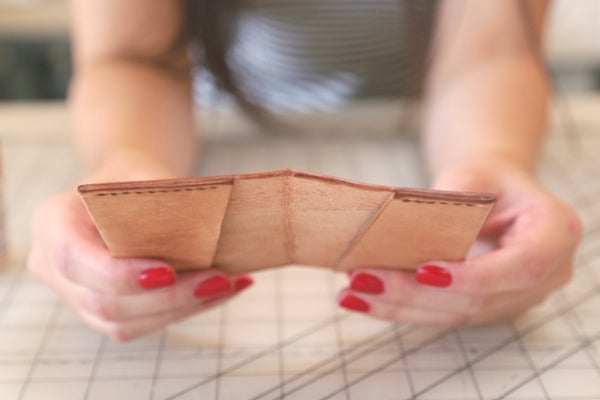Các bước làm một chiếc ví đơn giản
Mục lục
Step 1: Tools + Supplies I've attached three patterns in PDF format. Choose the style you'd like and cut it out carefully using a ruler and an x-acto knife. Lightly oil the grain side of the leather once it's been cut. You'll want to burnish the two short edges because we'll have a hard time getting to them later on once they're glued down and sewn into place. First, apply a little oil to the edges - if they're too dry it'll be very hard to get a nice burnish. Apply a bit of gum tragacanth to the edge, let it get tacky, and run a slicker over it. Keep repeating the process until the edges have slightly darkened and smoothed out. For more information on burnishing leather, check out my "how to burnish leather edges" instructable. Mark the side and middle fold lines on the flesh side (the fuzzy side) of the leather - I like to run a bone folder down the line. Dampen the side folds with a little water and then fold them over and clamp them into place. Be very careful about positioning them in the right place - you really want to get this right the first time! I like to use leather scraps in my clamps to protect the leather I'm using from getting marks in it. Clamp until dry and then check out how they're looking. If they're not folded perfectly, moisten the leather again and pound with a mallet. That will help flatten out the fold. :) For more info on this, check out my "how to make folds in leather" instructable. Moisten the middle fold line and fold the leather in half carefully - make sure all the edges line up nicely! I like to put this fold into the stitching pony and clamp the sides, too. :) I've marked the stitching lines on the pattern - use a groover to mark them on the side folds. Go slow and steady and work with dry leather for best results. Use a piece of tape or paper as a guide to apply the glue and keep it away from places it doesn't need to go. (It can make punching holes and sewing harder!) Apply your glue just along the edge of the inside pockets and clamp or hold until dry. For more information about glueing leather, check out my "how to glue leather for sewing" instructable. I'm using diamond chisels to do this - they're much more accurate than an awl for me! Moisten the leather lightly wait until it's almost dry, and then line up the chisels to punch your holes. Place your wallet on a piece of cardboard, inside holes up. Use a nice sharp awl and punch it down through the inside holes. Make sure you're punching straight up and down - no angled punches, or the stitching holes on the back of the wallet can come out crooked. This will leave you with a line of tiny holes on the outside of the wallet - this is how we'll line up our grooving and stitching holes on the other side. Using the tiny holes from the awl as a guide (they should lay right in the middle of your groove!), groove the outside of the wallet to match the inside. Wet the leather and let it go nearly dry again, and then line up the chisels with the holes and punch. At this point, it's a good idea to use the awl to punch through both layers again to make sure the holes are nice and clean. It'll speed up sewing. It's important to oil the leather before sewing because the wax on the thread can cause issues with getting the oil to soak in. Use an old piece of cloth and give the grain side of the leather a couple coats of oil. Pay special attention the to the stitching grooves - this will be your last chance to oil them properly. (I'm using jojoba for all my oiling - it's odorless and has a very long shelf life (5 years!) meaning it's not going to go rancid on you.) For this part, you'll want to thread some leather needles with about 16 inches of thread. I've got a whole instructable over this process - click here to learn how to saddle stitch. Use fine grit sandpaper to sand down the long sides of the wallet. This will help ensure both layers of leather the pockets are made of line up correctly. It'll make burnishing these edges much easier! Use gum tragacanth to burnish these edges just like the ones before. Remember to add jojoba oil to the edges if they're really dry. :) Once you're done, your edges (including where the pockets overlap) should be nice and slick. Once you're done sewing and burnishing, lightly oil the wallet one more time. Now you're good to go. :D
Trước khi làm bất cứ việc gì thì công đoạn set up luôn là quan trọng nhất, làm ví da handmade cũng không nằm ngoài việc đó. Đối với các bạn mới làm lần đầu mình chỉ đưa ra các dụng cụ cơ bản để tạo nên 1 sản phẩm một cách dễ dàng nhất
Step 2: Choose and Cut Out Your Pattern
Step 10: Groove and Punch the Outside of the Wallet
Step 11: Oil the Wallet
Step 12: Stitch the Wallet Pockets Down
Step 13: Sand the Long Edges
Step 14: Burnish the Long Edges
Step 15: Oil Again and Enjoy!
Category:
Thơ, văn
Posted on:
December 24th, 2020























